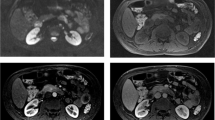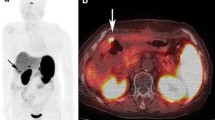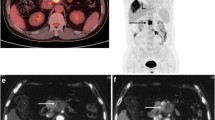Abstract
Objective
The objective of the present study was to evaluate the role of 68Ga-DOTA(0)-Phe(1)-Tyr(3)-octreotide (68Ga-DOTATOC) positron emission tomography computed tomography (PET-CT) for detection and staging of pancreatic neuroendocrine tumours (NETs).
Methods
Twenty patients with clinically suspected and/or histopathologically proven pancreatic NET underwent 68Ga-DOTATOC PET-CT imaging for staging and /or localisation of primary lesion. They also underwent contrast enhanced CT (CECT) and 8 patients underwent 18F-FDG PET-CT. SUVmax of primary and metastatic lesions were measured. Results were verified with histopathology for primary tumour and with clinical follow up/MRI and /or biopsy for metastatic disease. Results of 68Ga-DOTATOC PET-CT were compared to CECT and 18F-FDG PET-CT.
Results
68Ga-DOTATOC PET-CT correctly localised primary in all 20, CECT in 15 and 18F-FDG PET-CT in 2 patients. 68Ga-DOTATOC PET-CT demonstrated metastases in 13 patients, CECT in 7 and 18F-FDG PET-CT in 2. 68Ga-DOTATOC PET-CT emerged as the best investigation with 100% sensitivity and PPV for detecting primary tumour and metastatic disease. The detection rate of CECT was lower than 68Ga-DOTATOC PET-CT, both for primary tumour (20vs.15) or metastatic disease (13vs.7). 18F-FDG PET-CT performed poorly for primary and metastasis.
Conclusion
Ga-DOTATOC PET-CT is a very useful imaging investigation for diagnosing and staging pancreatic NET.






Similar content being viewed by others
References
Modlin IM, Lye KD, Kidd M (2003) A 5-decade analysis of 13,715 carcinoid tumors. Cancer 97:934–959
Kaltsas GA, Besser GM, Grossman AB (2004) The diagnosis and medical management of advanced neuroendocrine tumors. Endocr Rev 25:458–511
Eriksson B, Oberg K, Stridsberg M (2000) Tumor markers in neuroendocrine tumors. Digestion 62:33–38
Oberg K, Eriksson B (2005) Endocrine tumours of the pancreas. Best Pract Res Clin Gastroenterol 19:753–781
Ueberberg B, Tourne H, Redman A, Walz MK, Schmid KW, Mann K et al (2005) Differential expression of the human somatostatin receptor subtypes sst1 to sst5 in various adrenal tumors and normal adrenal gland. Horm Metab Res 37(12):722–728
Papotti M, Kuma U, Volante M, Pecchiono C, Patel YC (2001) Immunohistochemical detection of somatostatin receptor types 1–5 in medullary carcinoma of the thyroid. Clin Endocrinol 54:641–649
OdaY TanakaY, Naruse T, Sasanabe R, TsubamotoM FH (2002) Expression of somatostatin receptor and effects of somatostatin analog on pancreatic endocrine tumors. Surg Today 32(8):690–694
Papotti M, Bongiovanni M, Volante M, Allia E, Landolfi S, Helboe L et al (2002) Expression of somatostatin receptor types 1–5 in 81 cases of gastrointestinal and pancreatic endocrine tumors. A correlative immunohistochemical and reverse-transcriptase polymerase chain reaction analysis. Virchows Arch 440(5):461–475
Reubi JC (1995) Neuropeptide receptors in health and disease: the molecular basis for in vivo imaging. J Nucl Med 36:1825–1835
Reubi JC, Schar JC, Waser B, Wenger S, Heppeler A, Schmitt JS, Macke HR (2000) Affinity profiles for human somatostatin receptor subtypes SST1-SST5 of somatostatin radiotracers selected for scintigraphic and radiotherapeutic use. Eur J Nucl Med 27:273–282
Miederer M, Seidl S, Buck A, Scheidhauer K, Wester HJ, Schwaiger M, Perren A (2009) Correlation of immune-histopathological expression of somatostatin receptor 2 with standardised uptake values in 68Ga-DOTATOC PET/CT. Eur J Nucl Med Mol Imaging 36:48–52
Kaltsas G, Mukherjee JJ, Grossman AB (2001) The value of radiolabeled MIBG and octreotide in the diagnosis and management of neuroendocrine tumours. Clin Endocrinol 55:575–587
Kaltsas G, Rockall A, Papadogias D, Reznek R, Grossman AB (2004) Recent advances in radiological and radionuclide imaging and therapy of neuroendocrine tumours. Eur J Endocrinol 151:15–27
Hofmann M, Maecke H, Börner R, Weckesser E, Schöffski P, Oei L et al (2001) Biokinetics and imaging with the somatostatin receptor PET radioligand 68Ga-DOTATOC: preliminary data. Eur J Nucl Med 28:1751–1757
Buchmann I, Henze M, Engelbrecht S, Eisenhut M, Runz A, Schäfer M et al (2007) Comparison of 68Ga-DOTATOC PET and 111 In-DTPAOC (Octreoscan) SPECT in patients with neuroendocrine tumours. Eur J Nucl Med Mol Imaging 34:1617–1626
Kowalski J, Henze M, Schuhmacher J et al (2003) Evaluation of positron emission tomography imaging using [68Ga]-DOTA- D- Phe(1)- Tyr(3)-octreotide in comparison to [ 111 In]- DTPAOC SPECT. First results in patients with neuroendocrine tumors. Mol Imaging Biol 5:42–48
Gabriel M, Decristoforo C, Kendler D, Dobrozemsky G, Heute D, Uprimny C et al (2007) 68Ga-DOTA-Tyr3-octreotide PET in neuroendocrine tumors: comparison with somatostatinreceptor scintigraphy and CT. J Nucl Med 48:508–518
Heppeler A, Froidevaux S, Mäcke HR (1999) Radiometal-labeledmacrocyclic chelator derivatised somatostatin analogue with superb tumour-targeting properties and potential for receptormediated internal radiotherapy. Chem Eur J 5:1974–1981
Zhernosekov KP, Filosofor DV, Baum RP et al (2007) Processing of generator produced 68Ga for medical applications. J Nucl Med 48:1741–1748
US National Cancer Institute. SEER Database. http://seer.cancer.gov/ (accessed Nov 15, 2007).
Stridsberg M, Oberg K, Li Q et al (1995) Measurement of chromogranin A, chromogranin B (secretogranin I), chromogranin C (secretogranin II) and pancreastatin in plasma and urine from patients with carcinoid tumours and endocrine pancreatic tumours. J Endocrinol 144:49–59
Modlin IM, Kidd M, Latich I et al (2005) Current status of gastrointestinal carcinoids. Gastroenterology 128:1717–1751
Anderson MA, Carpenter S, Thompson NW et al (2000) Endoscopic ultrasound is highly accurate and directs management in patients with neuroendocrine tumors of the pancreas. Am J Gastroenterol 95:2271–2277
Gibril F, Jensen RT (2004) Diagnostic uses of radiolabelled somatostatin receptor analogues in gastroenteropancreatic endocrine tumours. Dig Liver Dis 36:S106–S120
Gastrointestinal carcinoid tumours (2007) In: Modlin IM, Gustafsson BI, Kidd M, eds. Advances in digestive disease. Bethesda, MD: AGA Institute Press, pp 203–218.
Kumar U, Sasi R, Suresh S, Patel A, Thangaraju M, Metrakos P et al (1999) Subtype-selective expression of the five somatostatin receptors (hSSTR1–5) in human pancreatic islet cells: a quantitative double-label immunohistochemical analysis. Diabetes 48(1):77–85
Arita T, Kuramitsu T, Kawamura M, Matsumoto T, Matsunaga N, Sugi K et al (1995) Bronchogenic carcinoma: incidence of metastases to normal sized lymph nodes. Thorax 50:1267–1269
Einstein DM, Singer AA, Chilcote WA, Desai RK (1991) Abdominal lymphadenopathy: spectrum of CT findings. Radiographics 11:457–472
Gross BH, Glatzer GM, Orringer MB (1988) Bronchogenic carcinoma metastatic to normalsized nodes: frequency and significance. Radiology 166:71–74
Reubi JC, Schär JC, Waser B, Wenger S, Heppeler A, Schmitt JS et al (2000) Affinity profiles for human somatostatin receptor subtypes SST1–SST5 of somatostatin radiotracers selected for scintigraphic and radiotherapeutic use. Eur J Nucl Med Mol Imaging 27:273–282
Buchmann M, Henze S, Engelbrecht M, Eisenhut A, Runz M, Schäfer T et al (2007) Comparison of 68Ga-DOTATOC PET and 111In-DTPAOC (Octreoscan) SPECT in patients with neuroendocrine tumours. Eur J Nucl Med Mol Imaging 34:1617–1626
Ruf J, Heuck F, Schiefer J, Denecke T, Elgeti F, Pascher A et al (2010) Impact of multiphase 68Ga-DOTATOC-PET/CT on therapy management in patients with neuroendocrine tumors. Neuroendocrinology 91:101–109
Prasad V, Ambrosini V, Hommann M, Hoersch D, Fanti S, Baum RP (2010) Detection of unknown primary neuroendocrine tumours (CUP-NET) using (68)Ga-DOTA-NOC receptor PET/CT. Eur J Nucl Med Mol Imaging 37:67–77
Kayani I, Bomanji JB, Groves A, Conway G, Gacinovic S, Win T et al (2008) Functional imaging of neuroendocrine tumors with combined PET/CT using 68Ga-DOTATATE (Dota-DPhe1, Tyr3-octreotate) and 18F-FDG. Cancer 112:2447–2455
Author information
Authors and Affiliations
Corresponding author
Rights and permissions
About this article
Cite this article
Kumar, R., Sharma, P., Garg, P. et al. Role of 68Ga-DOTATOC PET-CT in the diagnosis and staging of pancreatic neuroendocrine tumours. Eur Radiol 21, 2408–2416 (2011). https://doi.org/10.1007/s00330-011-2199-y
Received:
Revised:
Accepted:
Published:
Issue Date:
DOI: https://doi.org/10.1007/s00330-011-2199-y




